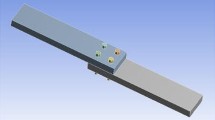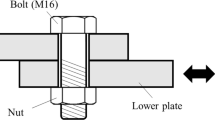Abstract
Vibrational energy transmission through the bolt-nut system joining two elastic structures is important as it is one of the widely used fastening methods. In this work, the effects of fastening torque and washers are studied as major factors influencing the vibrational power transmission. An experimental method using the structural intensity technique is employed to investigate the characteristics of the power flow through the joint. It is found that the energy dissipation decreases with the increase of fastening torque until reaching the nominal one in the elastic range. Also, the test result reveals that increasing the number of washers is effective in attenuating the vibration energy transmission through the joint, but it is found that using more than 3 washers is not efficient in reducing the vibration transmission.
Similar content being viewed by others
References
J. E. Shigley, J. K. Nisbett and R. G. Budynas, Mechanical engineering design, Eighth Ed., McGraw-Hill, New York (2006).
D. U. Noiseux, Measurement of power flow in uniform beams and plates, Journal of Acoustical Society of America, 47 (1) (1970) 238–247.
G. Pavic, Measurement of structure borne wave intensity, Part I: formulation of the methods, Journal of Sound and Vibration, 49 (2) (1976) 221–230.
J. Linjama and T. Lahti, Estimation of bending wave intensity in beams using the frequency response technique, Journal of Sound and Vibration, 153 (1) (1992) 21–36.
L. Cremer, M. Heckl and B. A. T. Petersson, Structureborne sound, Third Ed., Springer, Berlin (2005).
J. W. Verheij, Cross spectral density methods for measuring structure borne power flow on beams and pipes, Journal of Sound and Vibration, 70 (1) (1980) 133–139.
J. D. Blotter, D. E. Montgomery and R. L. West, Experimental active and reactive mechanical intensity in plates, Proc. of 13th International Modal Analysis Conference, 2 (1995) 1185–1191.
K. S. Alfredsson, Active and reactive structural energy flow, Journal of Vibration and Acoustics, 119 (1) (1997) 70–79.
C. H. Hansen and S. D. Snyder, Active control of noise and vibration, Spon, London (1997).
S. Gade, C. Fog and H. Herlufsen, Calibration of structural intensity probes, The 4th International Congress on Intensity Techniques, Senlis, France (1993) 175–182.
J. H. Bickford and S. Nassar, Handbook of bolts and bolted joints, Marcel Dekker, New York (1998).
L. Mi, G. F. Yin, M. N. Sun and X. H. Wang, Effects of preloads on joints on dynamic stiffness of a whole machine tool structure, Journal of Mechanical Science and Technology, 26 (2) (2012) 495–508.
G. Maidanik, Energy dissipation associated with gas pum** in structural joints, Journal of Acoustical Society of America, 40 (5) (1966) 1064–1072.
O. Zhang and J. A. Poirier, New analytical model of bolted joints, Journal of Mechanical Design, 126 (4) (2004) 721–728.
L. E. Goodman, A review of progress in analysis of interfacial slip dam**, Proc. of ASME Colloquium on Structural Dam**, New Jersey, USA (1959) 35–48.
Author information
Authors and Affiliations
Corresponding author
Additional information
Recommended by Associate Editor ** Woo Lee
Maryam Faiiazee received B.S. degree in Mechanical Engineering from Sharif University of Technology, Tehran, Iran, and earned the M.S. degree in Mechanical Engineering from KAIST, Daejeon, Korea. She has been affiliated at the R&D Center of the Korea Electric Power Co. as a researcher. Her major interest is the structural acoustics.
Jeong-Guon Ih has been a Professor of Mechanical Engineering at KAIST, Korea, since 1990. His major research interests are in the field of vibroacoustics, product sound quality, and electro-acoustics: Research topics are related with the inverse source identification and field rendering, design of virtual vibro-acoustic field, development of new actuators, and psychoacoustic design of products.
Rights and permissions
About this article
Cite this article
Faiiazee, M., Ih, JG. Effect of fastening method on the vibration energy flow through bolted structural joints. J Mech Sci Technol 32, 4583–4588 (2018). https://doi.org/10.1007/s12206-018-0904-3
Received:
Revised:
Accepted:
Published:
Issue Date:
DOI: https://doi.org/10.1007/s12206-018-0904-3




